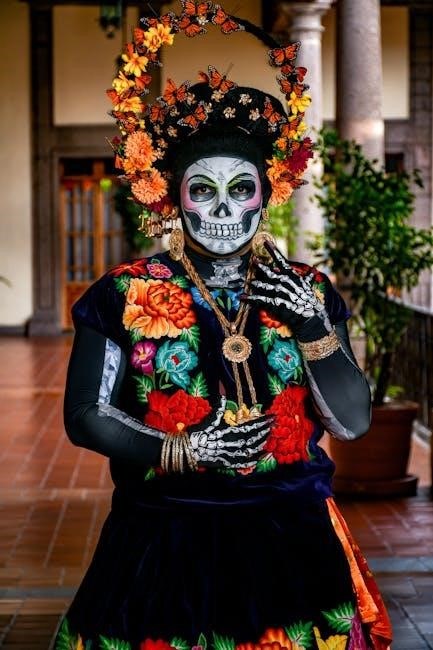The novel, available as a PDF, offers a convenient way to explore the Mirabal sisters’ courageous story, with accessible formatting and digital tools for enhanced reading experiences.
1.1 Overview of the Novel
In the Time of the Butterflies, written by Julia Alvarez, is a captivating novel that recounts the lives of the Mirabal sisters and their courageous resistance against the Trujillo dictatorship in the Dominican Republic. The story blends historical facts with fictional elements, exploring themes of courage, family, and oppression. The PDF version of the book is widely available, offering readers a convenient format to delve into the sisters’ struggles and triumphs, with features like chapter summaries and character analysis that enhance understanding of the narrative.
1.2 Historical Context
The novel is set against the backdrop of Rafael Trujillo’s brutal dictatorship in the Dominican Republic, spanning from 1930 to 1961. This period was marked by political repression, human rights violations, and a culture of fear. The Mirabal sisters’ story emerges from this oppressive era, highlighting the societal constraints and the regime’s control over everyday life. The PDF version of the book provides historical context, helping readers understand the tumultuous setting that shaped the sisters’ courageous acts of resistance and defiance.
1.3 Author Background: Julia Alvarez
Julia Alvarez, born in 1950 in New York to Dominican parents, draws heavily from her heritage in In the Time of the Butterflies. Her family’s experiences under the Trujillo regime deeply influenced her writing. Alvarez’s unique voice blends personal and historical narratives, creating a compelling portrayal of the Mirabal sisters. The PDF version of her novel highlights her lyrical prose and emotional depth, offering readers a vivid exploration of resistance, family, and identity. Alvarez’s work has become a cornerstone of Latin American literature.
Plot Summary
The novel, available as a PDF, tells the story of the Mirabal sisters and their courageous resistance against the oppressive Trujillo regime in the Dominican Republic.
2.1 The Mirabal Sisters
The Mirabal sisters, Patria, Minerva, María Teresa, and Dedé, are central to the novel. Their unique personalities and strengths drive the story. Patria, the eldest, is devout and nurturing. Minerva, fiercely independent, leads the resistance. María Teresa, emotional and artistic, documents their struggle. Dedé, the surviving sister, narrates their legacy. The PDF version highlights their bond and individual journeys, offering insights into their courage and sacrifice against the Trujillo dictatorship.
2.2 The Trujillo Dictatorship
The Trujillo dictatorship, led by Rafael Leónidas Trujillo, dominates the novel’s backdrop. His oppressive regime, marked by fear, control, and violence, shapes the Mirabal sisters’ lives. The PDF version of the book highlights Trujillo’s manipulation of power and his relentless suppression of dissent. The dictatorship’s pervasive influence is a central theme, illustrating the stifling political climate of the Dominican Republic during his rule. This context underscores the sisters’ courage and the cost of their resistance.
2.3 Key Events and Turning Points
The PDF version of In the Time of the Butterflies details pivotal moments that shape the narrative. The sisters’ initial defiance, their arrests, and the eventual tragic loss of Patria, Minerva, and María Teresa are central events. These turning points highlight their unwavering commitment to freedom and justice, despite the oppressive regime. The novel’s digital format allows readers to easily navigate these key scenes, enhancing the emotional impact of the Mirabal sisters’ journey.

Major Themes
The novel explores themes of courage, resistance, and the struggle for freedom, highlighting the strength of women and the impact of political oppression and family bonds.
3.1 Courage and Resistance
The Mirabal sisters embody extraordinary courage and resistance against the oppressive Trujillo regime. Their activism, despite constant danger, inspires others to challenge the dictatorship. The novel highlights their bravery in the face of imprisonment, torture, and personal loss, showcasing their unwavering commitment to freedom and justice. Their resistance becomes a symbol of hope for the oppressed, demonstrating the power of individual and collective courage in the fight against tyranny. The PDF version of the book provides a detailed exploration of these themes, making them accessible for deeper study and reflection.
3.2 Family and Sisterhood
The Mirabal sisters’ bond is a cornerstone of the novel, highlighting the strength of family ties and sisterhood. Their shared experiences, loyalty, and support for one another provide emotional sustenance amid adversity. The PDF version of the book delves into how their relationships evolve, emphasizing the role of family as both a source of comfort and a motivator for their resistance. This theme underscores the enduring power of sisterhood in the face of oppression and personal sacrifice.
3.3 Oppression and Freedom
The novel vividly portrays the oppressive regime of Trujillo, highlighting the Mirabal sisters’ struggle for freedom; The PDF version explores how their resistance against dictatorship symbolizes the broader fight for liberation. Through their experiences, Alvarez illustrates the psychological and physical toll of oppression, while also celebrating the resilience of the human spirit. The theme of freedom becomes a powerful symbol, driving the sisters’ actions and inspiring hope amidst despair, as they challenge the oppressive forces that seek to silence them.
3.4 Religion and Spirituality
Religion and spirituality play a significant role in the lives of the Mirabal sisters, offering solace and strength during oppressive times. The PDF version highlights how their Catholic faith intertwines with their political activism, providing moral guidance and resilience. Patria’s deep spirituality, for instance, fuels her resistance, while the sisters’ shared beliefs create a bond that transcends their struggles. Alvarez weaves religious themes into the narrative, illustrating how faith becomes both a personal and collective source of empowerment and hope in the face of tyranny.

Character Analysis
The PDF version delves into the Mirabal sisters’ distinct personalities and roles, highlighting their courage, resilience, and sacrifices. Each sister’s unique traits and motivations are explored in depth.
4.1 Patria Mirabal
Patria Mirabal, the eldest sister, is portrayed as deeply religious and maternal. Her journey from a devout Catholic to a revolutionary is central to the novel. The PDF highlights her internal conflicts and ultimate sacrifice, showcasing her unwavering commitment to family and freedom. Patria’s character embodies the struggle between faith and activism, making her a pivotal figure in the story’s emotional landscape.
4.2 Minerva Mirabal
Minerva Mirabal, the most politically active sister, is driven by a fierce determination to overthrow the Trujillo regime. The PDF version of the novel emphasizes her bold actions, such as organizing resistance groups and challenging authority. Her character symbolizes courage and defiance, inspiring others to join the fight for freedom. Minerva’s leadership and sacrifice make her a central figure in the story, highlighting the power of individual resistance against oppression.
4.3 María Teresa Mirabal
María Teresa Mirabal, the youngest sister, evolves from a shy, romantic girl to a courageous revolutionary. The PDF version highlights her emotional journey through diary entries, revealing her deep sensitivity and growth. Her love for her family and desire for freedom drive her to join the resistance. María Teresa’s tragic fate, alongside her sisters, underscores her ultimate sacrifice for justice, making her a poignant symbol of resilience and devotion to the fight against oppression.
4.4 Dedé Mirabal
Dedé Mirabal, the only sister to survive the Trujillo regime, narrates the story, offering a unique perspective on her family’s struggles. The PDF version emphasizes her role as the keeper of her sisters’ memories, showcasing her quiet strength and resilience. Unlike her siblings, Dedé chooses a path of caution, yet her loyalty and love for her family remain unwavering. Her character highlights the internal conflict between fear and admiration for her sisters’ courage, making her a complex and relatable figure in the novel.

Symbolism in the Novel
The butterflies symbolize the Mirabal sisters’ struggle for freedom and their enduring legacy. Their transformation mirrors the sisters’ courage and the impact they left behind.
5.1 The Butterflies as a Symbol
The butterflies in the novel symbolize the Mirabal sisters’ struggle for freedom and their enduring legacy. They represent transformation, resilience, and the beauty of resistance against oppression. The PDF version of the book highlights this symbolism through annotations, emphasizing how the butterflies embody the sisters’ courage and their ultimate sacrifice. This imagery resonates deeply, inspiring readers to reflect on the power of individual and collective resistance in the face of tyranny.
5.2 The Role of Nature
Nature in In the Time of the Butterflies serves as a source of solace and inspiration for the Mirabal sisters. The Dominican landscape, with its lush mountains and vibrant flowers, contrasts sharply with the oppressive regime, symbolizing freedom and resilience. The PDF version of the book includes annotations that highlight how nature mirrors the sisters’ emotional journeys, offering a deeper understanding of their connection to the land and their struggle for liberation.

The Title: Meaning and Significance
The title In the Time of the Butterflies symbolizes the Mirabal sisters’ transformation and resilience. Butterflies represent beauty, fragility, and freedom, mirroring the sisters’ struggle against oppression. The PDF version of the novel emphasizes this metaphor, highlighting how the butterflies’ fleeting existence parallels the sisters’ tragic yet inspiring fight for justice and democracy in the Dominican Republic under Trujillo’s dictatorship.
Historical Accuracy and Fictional Elements
Julia Alvarez’s In the Time of the Butterflies blends historical facts with fictional narrative, creating a compelling portrayal of the Mirabal sisters’ resistance against Trujillo’s regime. The PDF version highlights Alvarez’s meticulous research into the dictatorship’s atrocities, while also exploring the sisters’ personal lives through imaginative storytelling. This balance between history and fiction ensures the novel remains both informative and emotionally engaging, offering readers a deeper connection to the Mirabal sisters’ courageous legacy.
The PDF Version of the Book
The PDF version of In the Time of the Butterflies offers convenient access to the novel, featuring detailed analysis, chapter summaries, and enhanced readability for digital readers.
8.1 Availability and Accessibility
The PDF version of In the Time of the Butterflies is widely available online, offering easy access to readers worldwide; It can be downloaded from various e-book platforms, academic databases, and literary websites. The digital format ensures portability and convenience, allowing readers to access the novel on multiple devices. Additionally, features like adjustable font sizes and search functions enhance readability and accessibility, making it a popular choice for students, researchers, and book enthusiasts. This version also supports keyword searches, aiding in quick navigation and analysis.
8.2 Features of the Digital Version
The PDF version of In the Time of the Butterflies includes features like bookmarks for easy navigation, hyperlinked table of contents, and searchable text. Enhanced readability is achieved through adjustable font sizes and night mode options. Annotations and highlighting tools allow readers to engage deeply with the text. The digital version also preserves the original formatting, ensuring a seamless reading experience. These features make it an ideal resource for both casual readers and academic study, enhancing accessibility and user experience.

Study Guide and Analysis
The PDF version offers detailed chapter summaries, thematic analysis, and key quotes, providing readers with a comprehensive tool for understanding the novel’s depth and complexity.
9.1 Chapter Summaries
The PDF version of In the Time of the Butterflies includes detailed chapter summaries, breaking down the narrative into digestible sections. Each summary highlights key events, character development, and thematic elements, providing readers with a clear understanding of the story’s progression. This feature is particularly useful for students and analysts, offering a structured approach to studying the novel’s complex layers and historical context. The summaries also emphasize the Mirabal sisters’ individual and collective journeys, making the PDF a valuable resource for deeper analysis.
9.2 Key Quotes and Their Meanings
The PDF version of In the Time of the Butterflies highlights key quotes that encapsulate the novel’s core themes, such as courage, resistance, and familial bonds. These quotes, often accompanied by explanations, provide insight into the Mirabal sisters’ motivations and struggles. For instance, quotes about standing against the Trujillo regime underscore the sisters’ bravery, while others reflect their personal growth and sacrifices. The PDF format makes it easy to reference and analyze these pivotal moments, enhancing the reader’s understanding of the narrative’s emotional depth and historical significance.
Cultural Impact
The PDF version of In the Time of the Butterflies has amplified its cultural influence, making the story of the Mirabal sisters and Dominican heritage accessible worldwide, inspiring global readers.
10.1 Representation of Dominican Culture
The PDF of In the Time of the Butterflies vividly portrays Dominican culture through its rich depiction of traditions, language, and the resilience of its people. The novel highlights the vibrant heritage and the oppressive political climate under Trujillo, offering a poignant reflection of the nation’s history. This digital format ensures the story’s accessibility, preserving and sharing Dominican identity with a global audience, fostering cultural understanding and appreciation for the Mirabal sisters’ legacy.
10.2 The Novel’s Influence on Latin American Literature
In the Time of the Butterflies has profoundly impacted Latin American literature by showcasing the region’s tumultuous history and feminist struggles. The PDF version ensures its accessibility, spreading its message globally. Alvarez’s vivid storytelling has inspired authors to explore themes of resistance and cultural identity. The novel’s acclaim has elevated its status as a cornerstone of contemporary Latin American literature, fostering a deeper understanding of the region’s heritage and its people’s resilience.

Reception and Reviews
The PDF version of In the Time of the Butterflies has received widespread acclaim for its vivid storytelling and historical depth, resonating with readers globally.
Its accessible format has enhanced its popularity, making Alvarez’s powerful narrative about courage and resistance easily reachable to a broader audience.
11.1 Critical Acclaim
In the Time of the Butterflies has garnered widespread critical acclaim for its vivid storytelling and historical depth. The PDF version has further enhanced its accessibility, allowing readers to engage with Alvarez’s powerful narrative about courage and resistance. Critics praise the novel’s ability to weave personal and political struggles, making it a seminal work in Latin American literature. Its digital format has ensured its timeless relevance, reaching a broader audience and solidifying its place as a modern classic.
11.2 Audience Reception
The PDF version of In the Time of the Butterflies has been well-received by readers worldwide. Its accessibility and convenience have made it a popular choice for students, book clubs, and general readers. The digital format allows for easy navigation, with features like chapter summaries and key quotes, enhancing the reading experience. Readers praise the novel’s emotional depth and historical significance, making it a beloved and thought-provoking read in its digital form.
Adaptations and Interpretations
The PDF version of In the Time of the Butterflies has inspired various adaptations, including film and stage productions. These interpretations bring the Mirabal sisters’ story to life, capturing their courage and resilience. The novel’s themes of resistance and family bonds resonate across mediums, making it a versatile and enduring work; The digital format has also facilitated new readings and analyses, enriching the cultural impact of Alvarez’s masterpiece.

The Legacy of the Mirabal Sisters
The Mirabal sisters’ bravery against the Trujillo regime has left a lasting impact, inspiring future generations. Their story, as told in In the Time of the Butterflies, is a testament to resistance and sacrifice. The PDF version of the novel ensures their legacy is preserved, offering readers a digital gateway to their courageous journey. Their memory continues to symbolize hope and resilience, making them iconic figures in both history and literature.

Writing Style and Narrative Techniques
Julia Alvarez employs a vivid, lyrical prose in In the Time of the Butterflies, blending historical facts with fictional elements. The novel’s non-linear narrative alternates between the sisters’ perspectives, creating a layered, intimate portrayal of their lives. Alvarez’s use of flashbacks, dialogue, and symbolic imagery enhances the emotional depth, while her focus on the sisters’ unique voices fosters a connection with readers. The PDF version preserves this storytelling, allowing digital readers to experience the rich narrative techniques that bring the Mirabal sisters’ story to life.
Comparisons with Other Works
In the Time of the Butterflies draws parallels with other works exploring political oppression and female resilience, such as The House on Mango Street and One Hundred Years of Solitude. Alvarez’s vivid storytelling mirrors the magical realism of García Márquez, while her focus on sisterhood and rebellion echoes Cisneros’s themes of identity and resistance. The PDF version allows readers to easily compare these works digitally, enhancing the study of Latin American literature and feminist narratives.

Challenges and Controversies
The novel faced challenges due to its portrayal of the Trujillo regime, sparking debates about historical accuracy and artistic license. Some critics questioned the blending of fact and fiction, while others praised Alvarez’s bold storytelling. The PDF version has made the book more accessible, but its digital format has also raised concerns about piracy and copyright issues. Additionally, the novel’s feminist themes and critique of authoritarianism have led to discussions about censorship in certain regions.
In the Time of the Butterflies remains a powerful exploration of courage, family, and resistance. The Mirabal sisters’ legacy endures, inspiring readers to reflect on freedom and oppression. Julia Alvarez’s vivid storytelling bridges history and fiction, offering a timeless narrative. The novel’s themes of resilience and sacrifice continue to resonate globally, making it a significant work in Latin American literature and a testament to the human spirit’s ability to persevere against adversity.
